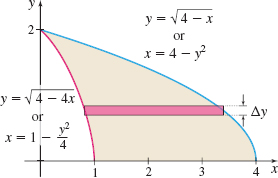EXAMPLE 6Finding the Area Between the Graphs of Two Functions
Find the area \(A\) of the region enclosed by the graphs of \(y=\sqrt{4-4x}, y=\sqrt{4-x}\), and the \(x\)-axis:
- (a) by partitioning the \(x\)-axis.
- (b) by partitioning the \(y\)-axis.
Solution (a) We begin by graphing the two equations and identifying the region whose area we seek. See Figure 11.

If we partition the \(x\)-axis, the area \(A\) of the region we seek must be expressed as the sum of the two areas \(A_{1}\) and \(A_{2}\) marked in the figure. [Do you see why? The bottom graph changes at \(x=1\) from \(y=\sqrt{4-4x}\) to \(y=0\) (the \(x\)-axis)].
Area \(A_{1}\) is the region enclosed by the graphs of \(y=\sqrt{4-x}\), and \(y=\sqrt{4-4x}\), and the line \(x=1\). Area \(A_{2}\) is the region enclosed by the graph \(y=\sqrt{4-x}\), the \(x\)-axis,
410
and the line \(x=1\). Then \begin{eqnarray*} A &=&A_{1}+A_{2}=\int_{0}^{1}( \sqrt{4-x}-\sqrt{4-4x})~{\it dx}+\int_{1}^{4}\sqrt{4-x}~{\it dx} \\[4pt] &=&\int_{0}^{1}\sqrt{4-x}~{\it dx}-\int_{0}^{1}\sqrt{4-4x}~{\it dx}+\int_{1}^{4}\sqrt{4-x}~{\it dx} \\[4pt] &=&\int_{0}^{4}\sqrt{4-x}~{\it dx}-\int_{0}^{1}\sqrt{4-4x}~{dx}\!\qquad {\color{#0066A7}{\hbox{$\int_{0}^{1}\sqrt{ {4-x}}{~{dx}}+\int_{1}^{4}\sqrt{{4-x}}{~{dx}}=\int_{0}^{4}\sqrt{{4-x}}{~{dx}}$}}} \end{eqnarray*}
To find the first integral, we use the substitution \(u=4-x\). Then \({\it du}=-{\it dx}\), and \begin{equation*} \int_{0}^{4}\sqrt{4-x}~{\it dx}=-\int_{4}^{0}u^{1/2}{\it du}=\int_{0}^{4}u^{1/2}~{\it du}= \left[ \dfrac{2}{3}u^{3/2}\right] _{0}^{4}=\frac{2}{3}( 8-0) = \frac{16}{3} \end{equation*}
For the other integral, we use the substitution \(u=4-4x\). Then \({\it du}=-4\,{\it dx}\), or equivalently, \({\it dx}=-\dfrac{{\it du}}{4}\), and \begin{equation*} \int_{0}^{1}\sqrt{4-4x}~{\it dx}=-\frac{1}{4}\int_{4}^{0}u^{1/2}~{\it du}=\dfrac{1}{4} \int_{0}^{4}u^{1/2}~{\it du}=\dfrac{1}{4}\left[ \dfrac{2}{3}u^{3/2}\right] _{0}^{4}= \frac{1}{6}( 8-0) =\frac{4}{3} \end{equation*}
The area \(A=\dfrac{16}{3}-\dfrac{4}{3}=4\) square units.
(b) Figure 12 shows the graphs of \(y=\sqrt{4-4x}\) and \(y=\sqrt{4-x}\) and the region whose area \(A\) we seek. Since the graphs of \(y=\sqrt{4-4x}\) and \(y=\sqrt{4-x}\) satisfy the Horizontal-line Test for \(0\leq y\leq 2\), we can express \(y=\sqrt{4-4x}\) as a function \(x=f(y)\) and \(y=\sqrt{4-x}\) as a function \(x=g(y)\). To find \(x=f(y)\), we solve \(y=\sqrt{4-4x}\) for \(x\), where \(x\geq 0\): \begin{eqnarray*} y&=&\sqrt{~4-4x} \\[4pt] y^{2}&=&4-4x \\[4pt] x&=&\dfrac{4-y^{2}}{4} \\[4pt] x&=&f(y)=1-\dfrac{y^{2}}{4} \end{eqnarray*}
To express \(y=\sqrt{4-x}\) as a function \(x=g(y)\), we solve for \(x\), where \(x\geq 0\): \begin{eqnarray*} y &=&\sqrt{~4-x} \\[4pt] y^{2} &=&4-x \\[4pt] x &=&g(y)=4-y^{2} \end{eqnarray*}
The graph of \(x=g(y)=4-y^{2}\) is to the right of the graph of \(x=f(y)=1-\dfrac{y^{2}}{4}, 0\leq y \leq 2\). So, \(g(y)\geq f(y)\). Then \begin{eqnarray*} A&=&\int_{0}^{2}[ g(y)-f(y)]\, {\it dy}=\int_{0}^{2}\left[ (4-y^{2})-\left( 1-\dfrac{y^{2}}{4}\right) \right] {\it dy}=\int_{0}^{2}\left( 3-\dfrac{3y^{2}}{4}\right) {\it dy}\\[4pt] &=&\left[ 3y-\dfrac{y^{3}}{4}\right] _{0}^{2}=6-\dfrac{8}{4}=4\hbox{ square units} \end{eqnarray*}
